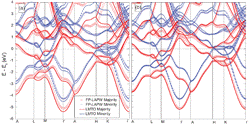Department of Physics and Astronomy: Publications and Other Research

Kirill Belashchenko Publications
Document Type
Article
Date of this Version
2016
Citation
PHYSICAL REVIEW B 93, 241401(R) (2016)
Abstract
Electrostatic gating enables key functionality in modern electronic devices by altering the properties of materials. While classical electrostatics is usually sufficient to understand the effects of gating in extended systems, the inherent quantum properties of gating in nanostructures offer unexplored opportunities for materials and devices. Using first-principles calculations for Co/bilayer graphene, Co/BN/graphene, and Co/BN/benzene, as well as a simple physical model, we show that heterostructures with two-dimensional materials yield tunable magnetic proximity effects. van der Waals bonding is identified as a requirement for large electronic structure changes by gating, enabling both the magnitude and sign change of spin polarization in physisorbed graphene. The ability to electrically reverse the spin polarization of an electrode provides an alternative to using the applied magnetic field or spin transfer torque in spintronic devices, thus transforming a spin valve into a spin transistor.


Comments
©2016 American Physical Society